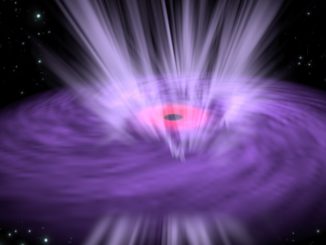
On 20 March 2018, a star in the constellation Carina suddenly flared into a nova as gas from a companion sun fell onto the surface of a white dwarf, triggering a runaway thermonuclear explosion that blew off the accumulated material in a titanic outburst.
The All-Sky Automated Survey for Supernovae detected the explosion, one of a wave of flares. In a lucky break, one satellite in the Bright Target Explorer cubesat constellation – BRITE – happened to be looking in that direction and was able to follow the evolution of subsequent flares in unprecedented detail.
NASA’s Fermi gamma ray satellite caught three outbursts, and the nova’s final flare was captured by the NuSTAR space telescope.
The result: direct evidence that most of a nova’s visible light is generated by shock waves, the abrupt changes in the pressure and temperature in the explosion’s debris.
“Thanks to an especially bright nova and a lucky break, we were able to gather the best-ever visible and gamma-ray observations of a nova to date,” said Elias Aydi, a Michigan State University astronomer who led an international team representing 40 institutions.
“The exceptional quality of our data allowed us to distinguish simultaneous flares in both optical and gamma-ray light, which provides smoking-gun evidence that shock waves play a major role in powering some stellar explosions.”
Nova explosions release 10,000 to 100,000 times the energy generated by the Sun in 12 months and about 10 are spotted in the Milky Way each year. The mechanism triggering a nova is similar to the one that generates a much more powerful type 1a supernova. But in the latter case, enough material accumulates on the white dwarf’s surface to ignite an explosion that completely destroys the star.
While powerful by human standards, novae were not expected to generate the energies necessary to produce gamma rays. But Fermi has detected 14 novae to date and gamma rays appear at roughly the same time visible light from a blast is peaking.
In 2015, Brian Metzger at Columbia University and his colleagues wrote a paper showing how gamma-ray data from Fermi, when compared with optical observations, could shed light on shock waves forming in the aftermath of a nova. Two years later, a study led by Kwon-Lok Li at Michigan State University found the gamma ray and optical emissions observed in nova V5856 Sagittarii rose and fell in step with each other.
Those conclusions were confirmed in spectacular fashion by the V906 Carinae observations, according to a paper published in Nature Astronomy.
The researchers conclude that during the first few days of V906 Carinae’s outburst, the orbital motion of the two stars swept up thick clouds of material in multiple doughnut-like shells that were oriented roughly edge-on from our vantage point on Earth. The cloud initially expanded outward at about 2.2 million kph (1.3 million mph), about the speed of the solar wind.
Then, an outflow moving twice as fast, likely generated by residual nuclear reactions on the white dwarf’s surface, rammed into the denser regions of the doughnut, generating shock waves that produced gamma rays and visible light. About three weeks after the initial outburst, an even faster-moving outflow smashed into the slower debris, creating fresh shock waves and another set of gamma-ray and optical flares.
“When we compare the Fermi and BRITE data, we see flares in both (visible light and gamma rays) at about the same time, so they must share the same source — shock waves in the fast-moving debris,” said Koji Mukai, an astrophysicist at NASA’s Goddard Space Flight Center.
“When we look more closely, there is an indication that the flares in gamma rays may lead the flares in the visible. The natural interpretation is that the gamma-ray flares drove the optical changes.”



